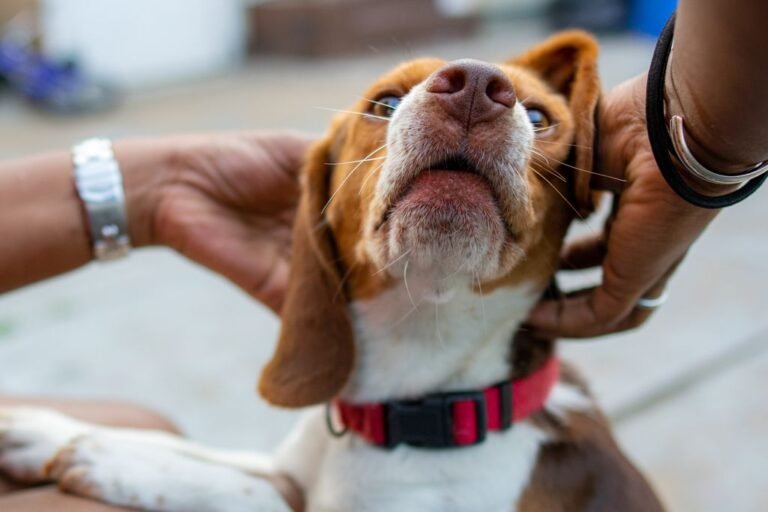Recognizing and Responding to Signs of Depression in Pets
Depression is a common mental health issue that affects not only humans but also our beloved pets. Recognizing and responding to signs of depression in pets is crucial for their well-being. In this article, we will explore what pet depression is, its causes, and the signs and symptoms to look out for. We will also discuss how to recognize depression in dogs and cats, as well as provide helpful tips on how to help your depressed pet. Finally, we will touch on when to seek professional help and the treatment options available for pet depression.
Key Takeaways
- Pet depression is a real and serious condition that can affect dogs and cats.
- Signs of pet depression may include changes in behavior and physical symptoms.
- It is important to differentiate between sadness and depression in pets.
- Creating a stimulating environment, maintaining a routine, and providing exercise and mental stimulation can help alleviate pet depression.
- If you suspect your pet is depressed, it is important to consult a veterinarian for proper diagnosis and treatment.
Understanding Depression in Pets

What is pet depression?
Pet depression is a condition that can affect dogs, cats, and other animals. It is characterized by a persistent and noticeable change in behavior and mood. Just like humans, animals can experience feelings of sadness, loneliness, and anxiety. However, when these feelings persist for an extended period and significantly impact the animal’s daily life, it may be a sign of depression.
Depression in pets can be caused by various factors, including changes in their environment, loss of a companion, illness or pain, and evidence of animal depression. It is important to recognize the signs and symptoms of pet depression to provide the necessary support and care.
To better understand pet depression, let’s take a look at some common signs and symptoms that pet owners should be aware of:
Causes of pet depression
There are several factors that can contribute to pet depression. One possible cause is a lack of mental stimulation and physical activity. Pets, especially dogs, thrive on daily exercise and mental engagement. Without regular playtime and interaction, they can become bored and lethargic. Another factor is a change in routine or environment. Pets are creatures of habit and sudden disruptions to their daily lives can be stressful. This can include moving to a new home, the addition or loss of a family member, or a change in their daily schedule. Additionally, a lack of socialization can also lead to pet depression. Animals are social beings and need regular interaction with humans and other animals to thrive. If they are isolated or do not receive enough attention and affection, they may experience feelings of loneliness and sadness.
Signs and symptoms of pet depression
Recognizing the signs and symptoms of pet depression is crucial in order to provide the necessary support and care for your furry friend. Depression in pets can manifest in various ways, and it’s important to pay attention to any changes in their behavior or overall well-being. Some common signs of pet depression include loss of appetite, lethargy, withdrawal from social interaction, and changes in sleep patterns. If you notice any of these signs, it’s important to consult with a veterinarian to rule out any underlying medical conditions. Additionally, keep an eye out for any unusual behaviors or changes in your pet’s daily routine. Providing a stimulating environment, maintaining a consistent routine, and ensuring regular exercise and mental stimulation can all contribute to improving your pet’s well-being. Remember, your pet’s happiness and mental health are just as important as their physical health.
Recognizing Depression in Dogs

Behavioral changes in depressed dogs
When a dog is experiencing depression, there are several behavioral changes that you may notice. Lack of interest in activities that they used to enjoy, such as playing or going for walks, is a common sign. They may also exhibit changes in appetite, either eating significantly less or more than usual. Another behavioral change to look out for is withdrawal or social isolation. Depressed dogs may prefer to spend time alone and avoid interaction with their owners or other pets.
It’s important to note that these behavioral changes can also be indicative of other health issues, so it’s essential to consult with a veterinarian for a proper diagnosis. If your dog is showing these signs, it’s crucial to provide them with a supportive and comforting environment. Spend quality time with your dog, engage in activities that they enjoy, and provide them with plenty of love and attention. Additionally, maintaining a consistent routine can help provide a sense of stability and security for your dog during this challenging time.
Here are some tips to help your dog cope with pet loss:
- Provide a safe and comfortable space for your dog to grieve. This can include a cozy bed or blanket where they can retreat to when they need some alone time.
- Engage in activities that your dog enjoys, such as playing with their favorite toys or going for walks in their favorite park.
- Consider introducing a new companion for your dog, such as another pet or a stuffed animal, to help alleviate their loneliness.
Remember, every dog is unique, and their response to depression may vary. It’s important to be patient and understanding as you support your dog through this difficult time.
Physical signs of depression in dogs
When a dog is experiencing depression, there are several physical signs that may indicate their emotional state. These signs can include a decrease in appetite, weight loss, lethargy, and changes in grooming habits. App control is an important aspect of monitoring a dog’s behavior and physical well-being. By using an app to track their eating habits, exercise levels, and overall mood, you can gain valuable insights into their daily routine and identify any changes that may be indicative of depression. It’s important to note that while these physical signs can be indicative of depression, they can also be symptoms of other underlying health issues. If you notice any of these signs in your dog, it’s best to consult with a veterinarian to rule out any medical causes and determine the appropriate course of action.
How to differentiate between sadness and depression in dogs
When trying to determine whether your dog is experiencing sadness or depression, it’s important to pay attention to their behavior and overall well-being. Sadness is typically a temporary state that may be caused by a specific event, such as the loss of a loved one or a change in their environment. Depression, on the other hand, is a more persistent and long-lasting condition that affects your dog’s daily life.
Here are some key factors to consider when differentiating between sadness and depression in dogs:
- Duration: Sadness is usually short-lived and may resolve on its own within a few days or weeks. Depression, on the other hand, can last for an extended period of time, often lasting for several weeks or even months.
- Appetite and weight: Dogs experiencing sadness may have a temporary decrease in appetite, but it usually returns to normal fairly quickly. Dogs with depression may have a significant decrease in appetite and may experience weight loss.
- Energy levels: Sad dogs may still have moments of excitement and playfulness, while depressed dogs often have a noticeable decrease in energy and may seem lethargic.
- Interest in activities: Dogs with sadness may still show interest in their favorite activities, although they may be less enthusiastic. Depressed dogs often lose interest in activities they once enjoyed and may withdraw from social interactions.
It’s important to note that these are general guidelines and every dog is unique. If you suspect that your dog may be experiencing depression, it’s best to consult with a veterinarian for a proper diagnosis and guidance on how to support your dog’s mental well-being.
Identifying Depression in Cats

Common signs of depression in cats
Depression in cats can manifest in various ways. Lethargy and a lack of interest in activities that were once enjoyable are common signs to look out for. Cats may also exhibit changes in appetite, either eating significantly less or more than usual. Withdrawal from social interaction and spending more time alone is another indication of feline depression. Additionally, cats may display excessive grooming or neglect their grooming altogether. It’s important to note that these signs can also be indicative of other health issues, so it’s essential to consult a veterinarian for a proper diagnosis. If you suspect your cat may be depressed, consider implementing the following strategies to help improve their well-being:
How to tell if your cat is depressed
If you suspect that your cat may be experiencing depression, there are several signs to look out for. Lack of interest in activities that your cat used to enjoy, such as playing or grooming, can be a red flag. Additionally, changes in appetite or weight loss may indicate a depressed state. Keep an eye out for excessive sleeping or withdrawal from social interaction, as these behaviors can also be indicative of depression. It’s important to note that these signs may also be symptoms of other underlying health issues, so it’s crucial to consult with your veterinarian for a proper diagnosis. If your cat is showing any of these signs, it’s essential to provide a supportive and stimulating environment to help alleviate their depression. This can include engaging in interactive play, providing new toys or scratching posts, and creating a safe and comfortable space for your cat to retreat to when they need some alone time.
Cat breeds prone to depression
While depression can affect cats of any breed, there are certain cat breeds that may be more prone to experiencing this condition. Natural ingredients in their genetic makeup, such as a predisposition to anxiety or sensitivity to environmental changes, can make them more susceptible to developing depression. Some cat breeds that have been observed to be more prone to depression include the Siamese, Persian, and Maine Coon. It’s important to note that individual cats within these breeds may still have unique personalities and experiences, so not all cats of these breeds will necessarily experience depression. If you have a cat of one of these breeds, it’s important to be aware of the signs and symptoms of depression and provide them with the necessary support and care.
Helping Your Depressed Pet

Creating a stimulating environment
Creating a stimulating environment for your depressed pet is crucial in helping them overcome their symptoms and improve their overall well-being. Providing plenty of mental and physical stimulation can help alleviate boredom and promote a sense of purpose. Here are some ways you can create a stimulating environment for your pet:
- Interactive toys and puzzles: Engage your pet’s mind with interactive toys and puzzles that require problem-solving skills. This can help keep their brain active and prevent them from feeling bored.
- Enrichment activities: Incorporate enrichment activities into your pet’s daily routine, such as hiding treats around the house or setting up a scavenger hunt. This can provide mental stimulation and keep them engaged.
- Playtime: Set aside dedicated playtime with your pet, using toys that encourage physical activity and interaction. This can help boost their mood and provide a bonding experience.
Remember, creating a stimulating environment is just one aspect of helping your depressed pet. It’s important to also consider other factors such as routine and structure, as well as exercise and mental stimulation. By providing a supportive and engaging environment, you can make a positive impact on your pet’s well-being.
The importance of routine and structure
Routine and structure are essential for helping your depressed pet. Consistency in daily activities can provide a sense of security and stability, which is important for their emotional well-being. Establishing a regular feeding schedule and consistent exercise routine can help regulate their biological rhythms and promote a sense of normalcy.
In addition, providing a safe and comfortable environment with designated spaces for rest, play, and interaction can give your pet a sense of control and predictability. Creating a daily routine that includes activities such as walks, playtime, and mental stimulation can help alleviate boredom and provide a sense of purpose.
Furthermore, positive reinforcement and reward-based training can help boost your pet’s confidence and sense of accomplishment. By setting clear expectations and rewarding desired behaviors, you can help your pet feel more secure and motivated.
Remember, patience is key when establishing routine and structure for a depressed pet. It may take time for them to adjust and feel comfortable, but with your love and support, they can overcome their depression and thrive once again.
Exercise and mental stimulation for depressed pets
Regular exercise and mental stimulation are crucial for helping your depressed pet. Physical activity not only helps to improve their overall well-being but also releases endorphins that can boost their mood. Engaging in playtime and interactive activities with your pet can provide them with mental stimulation and help alleviate their symptoms of depression. Additionally, socialization with other animals or humans can help reduce feelings of loneliness and anxiety. It is important to create a structured routine that includes daily exercise and mental stimulation to keep your pet engaged and active.
Seeking Professional Help

When to consult a veterinarian
If you notice any concerning changes in your pet’s behavior or overall well-being, it is essential to consult a veterinarian. They have the expertise to properly assess your pet’s condition and provide appropriate treatment. Efficient and timely intervention can make a significant difference in your pet’s recovery. Here are some signs that indicate it’s time to seek professional help:
- Persistent changes in appetite or weight
- Excessive lethargy or lack of energy
- Withdrawal from social interaction
- Aggressive or destructive behavior
Remember, your veterinarian is there to support you and your pet’s health. Don’t hesitate to reach out if you have any concerns.
Treatment options for pet depression
When it comes to treating pet depression, there are several options available to help your furry friend feel better. Catlink, Fresh 2 Pro, and other medications can be prescribed by a veterinarian to address the underlying causes of depression. These medications are designed to regulate brain chemistry and improve mood. Additionally, routine care plays a crucial role in managing pet depression. Providing a stimulating environment with plenty of mental and physical exercise can help alleviate symptoms. Regular playtime and interaction with your pet are important for their overall well-being. It’s also essential to establish a structured routine and consistent schedule to provide a sense of stability and security. Lastly, professional help should be sought if your pet’s depression persists or worsens. A veterinarian can provide guidance on the best course of action and recommend additional treatments or therapies.
The role of medication in managing pet depression
Taking medication can be an effective way to lessen extreme or debilitating symptoms of pet depression. Medication can help with sleep disorders, hyperarousal, emotional reactivity, and intrusive or recurring thoughts and images. It is important to note that what works for one pet may not work for another, so it’s essential to consult with a veterinarian to find the right medication and dosage for your pet’s specific needs. Additionally, medication should be used as part of a comprehensive treatment plan that includes creating a stimulating environment, maintaining a routine and structure, and providing exercise and mental stimulation for your depressed pet.
Seeking professional help is an important step in ensuring the health and well-being of your beloved pets. At Whisker Wellbeing, we understand the importance of holistic and natural care for cats and dogs. Our mission is to provide a wide range of products, including CBD, hemp, and other natural options, that are specifically designed to enhance the physical and emotional quality of life for pets. Whether you’re looking for supplements, grooming products, or behavioral support, we have everything you need to keep your furry friends happy and healthy. Visit our website today to explore our offerings and give your pets the care they deserve.
Conclusion
In conclusion, recognizing and responding to signs of depression in pets is crucial for their well-being and overall mental health. Just like humans, pets can experience feelings of sadness, loneliness, and anxiety. By being attentive to changes in their behavior, providing a loving and supportive environment, and seeking professional help when needed, we can help our furry friends overcome depression and lead happier lives. Remember, our pets rely on us for their emotional well-being, and it is our responsibility to ensure they receive the care and attention they deserve. So let’s be proactive in recognizing and addressing signs of depression in our pets, because they deserve nothing less than our love and support.
Frequently Asked Questions
Can pets really experience depression?
Yes, pets can experience depression just like humans. They can feel sad, lose interest in activities, and show other signs of depression.
What are the common causes of pet depression?
There are several factors that can contribute to pet depression, including major life changes, loss of a companion, illness or pain, and lack of socialization or mental stimulation.
How can I tell if my pet is depressed?
Some common signs of pet depression include changes in appetite, sleep patterns, and behavior. They may also exhibit withdrawal, lack of interest, or excessive grooming.
Can depression in pets be treated?
Yes, depression in pets can be treated. It is important to consult with a veterinarian who can provide a proper diagnosis and recommend appropriate treatment options.
What can I do to help my depressed pet?
Creating a stimulating environment, maintaining a routine, providing mental and physical exercise, and offering plenty of love and attention can help improve your pet’s mood.
When should I seek professional help for my pet’s depression?
If you notice persistent signs of depression in your pet or if their behavior changes dramatically, it is recommended to consult with a veterinarian for further evaluation and guidance.







